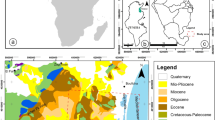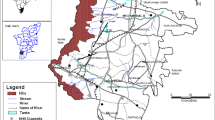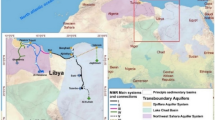Abstract
Using the principles of Quaternary geology and geomorphology, this study analyzed the genetic types, composition, lithofacies and spatial distribution of Quaternary deposits in the first terrace sediments adjacent to the Yangtze River in Wuhan. These sediments exhibit a typical binary structural sedimentation rhythm, where sedimentary particles in the same sediment are sequenced progressively fine downstream with river flow which also has obvious grading regularity that affects the engineering properties of these materials. A transverse cross-section outwards from the river channel indicates that the lower sand layer thickness decreases, while the thickness of the upper soft and interlayered sediments progressively increases with distance from the channel. The permeability of the aquifers increases monotonically with depth and the permeability coefficient is anisotropic. From upstream to downstream, the anisotropy coefficient increases significantly and this factor needs to be considered when designing a dewatering system. The main geotechnical engineering problems caused by underground water during the excavation of underground space in sediments adjacent to large river systems are put forward, and the corresponding countermeasures are also recommended.











Similar content being viewed by others
Data availability
Some or all data that support the findings of this study are available from the corresponding author upon reasonable request.
References
Bawden GW, Thatcher W, Stein RS, Hudnut KW, Peltze RG (2001) Tectonic contraction across Los Angeles after removal of groundwater pumping effects. Nature 412(6849):812–815
Calderhead AI, Therrien R, Rivera A, Martela R, Garfiasd J (2011) Simulating pumping-induced regional land subsidence with the use of InSAR and field data in the Toluca Valley. Mexico Adv Water Resour 34:83–97
Chen J, Li Z, Zhao X, Li H (2011) Experimental study of bentonite–soil mixtures as anti-seepage materials of constructed wetlands. J Environ Sci Health Part A 46(7):729–735
Chen JJ, Zhang LY, Zhang JF, Zhu YF, Wang JH (2013) Field tests, modification and application of deep soil mixing method in soft clay. J Geotech Geoenviron Eng 139(1):24–34. https://doi.org/10.1061/(ASCE)GT.1943-5606.0000746
Chen J, Jia S, Zhang X (2017) Back analysis and application of confined aquifer hydrogeological parameters based on pumping test. Geotech Geol Eng 35(6):2851–2861
Cheng PD, Li L, Tang J, Wang DZ (2011) Application of time-varying viscous grout in gravel-foundation anti-seepage treatment. J Hydrodyn Ser B 23(3):391–397
DB42/T, Construction Department of Hubei Province, Hubei Administration of Quality and Technology Supervision (2012) Technical Specification for excavation engineering. DB42/T 159-2012 (in Chinese)
Fan SK, Yang YW (2010) Groundwater control and practice of deep foundation pits in 1st terrace along Yangtze river. Chin J Geotech Eng 32:63–69 (in Chinese)
Frank R, Baduin C, Driscoll R, Kavvadas M, Krebs Ovesen N, Orr T, Schuppener B, (2004) Designer’s guide to EN1997-1, EUROCODE 7. Geotechnical Design—General Rules. Thomas Telford, London
Huang YC, Xu YQ (2014) Numerical simulation analysis of dewatering and recharge process of deep foundation pits. Chin J Geotechn Eng 56(supp.2): 299–303 (in Chinese)
Huang Y, Bao YJ, Wang YH (2015) Analysis of geoenvironmental hazards in urban underground space development in Shanghai. Nat Hazards 75:2067–2079. https://doi.org/10.1007/s11069-014-1414y
Jiao JJ, Leung C, Ding GP (2008) Changes to the groundwater system, from 1888 to present, in a highly-urbanized coastal area in Hong Kong. China Hydrogeol J 16(8):1527–1539
Jurado A, De Gaspari F, Vilarrasa V, Bolster D, Sánchez-Vila X, Fernàndez-Garcia D, Tartakovsky DM (2012) Probabilistic analysis of groundwater-related risks at subsurface excavation sites. Eng Geol 125(1):35–44. https://doi.org/10.1016/j.enggeo.2011.10.015
Lin HT, Tan YC, Chen CH, Yu HL, Wu SC, Ke KY (2010) Estimation of effective hydrogeological parameters in heterogeneous and anisotropic aquifers. J Hydrol 389(1–2):57–68
Liu X, Feng X, Lu X, Wu Z, Wang Y (2009) Study on technique of foundation pit for shield receiving shaft of river-crossing tunnel in the first Yangtze River’s Terrace. ICPTT ASCE
Liu GF, Xu YQ, Wu XC (2014) Study on the dewatering effect influenced by the embedded depth of diaphragm wall in ultra deep foundation pits. Geotech Investig Surv 1:51–58 (in Chinese)
Ma L, Xu YS, Shen SL, Sun WJ (2014) Evaluation of the hydraulic conductivity of aquifers with piles. Hydrogeol J 22(2):371–382
Ni JC, Cheng WC (2011) Shield machine disassembly in grouted soils outside the ventilation shaft: a case history in Taipei rapid transit system (TRTS). Tunn Undergr Space Technol 26(2):435–443
Ni JC, Cheng WC, Ge L (2011) A case history of field pumping tests in a deep gravel formation in the Taipei Basin. Taiwan Eng Geol 117(1–2):17–28. https://doi.org/10.1016/j.enggeo.2010.10.001
Pickles AR, Lee SW, Norcliffe BAW (2003) Groundwater and ground movement around deep excavation. Proc Inst Civil Eng Geotech Eng 156(3):147–158
Pujades E, Carrera J, Vázquez-Suñé E, Jurado A, Vilarrasa V, Mascuñano-Salvador E (2012b) Hydraulic characterization of diaphragm walls for cut and cover tunnelling. Eng Geol 125(27):1–10
Pujades E, Ander L, Carrera J, Vázquez-Suñé E, Jurado A (2012a) Barrier effect of underground structures on aquifers. Eng Geol 145–146-(6):41–49
Pujades E, Vázquez-Suñé E, Carrera J, Jurado A (2014) Dewatering of a deep excavation undertaken in a layered soil. Eng Geol 178:15–27
Pujades E, De Simone S, Carrera J, Vázquez-Suñé E, Jurado A (2017) Settlements around pumping wells: analysis of influential factors and a simple calculation procedure. J Hydrol 548:225–236
Shaqour FM, Hasan SE (2008) Groundwater control for construction purposes: a case study from Kuwait. Environ Geol 53(8):1603–1612
Shen SL, Han J, Du YJ (2008) Deep mixing induced property changes in surrounding sensitive marine clays. J Geotech Geoenviron Eng 134(6):845–854. https://doi.org/10.1061/(ASCE)1090-0241(2008)134:6(845)
Shen SL, Wang ZF, Horpibulsuk S, Kim YH (2013) Jet grouting with a newly developed technology: the Twin-Jet method. Eng Geol 152(1):87–95. https://doi.org/10.1016/j.enggeo.2012.10.018
Shen SL, Wu YX, Misra A (2017) Calculation of head difference at two sides of a cut-off barrier during excavation dewatering. Comput Geotech 91:192–202. https://doi.org/10.1016/j.compgeo.2017.07.014
Tan Y, Lu Y (2018) Responses of shallowly buried pipelines to adjacent deep excavations in Shanghai soft ground. J Pipel Syst Eng Pract ASCE 9(2):05018002
Tan Y, Wang D (2015a) Structural behaviors of large underground earth-retaining systems in Shanghai. I: unpropped circular diaphragm wall. J Perform Constr Facil ASCE 29(2):04014058. https://doi.org/10.1061/(ASCE)CF.1943-5509.0000521
Tan Y, Wang D (2015b) Structural behaviors of large underground earth-retaining systems in Shanghai. II: multipropped rectangular diaphragm wall. J Perform Constr Facil ASCE 29(2):04014059. https://doi.org/10.1061/(ASCE)CF.1943-5509.0000535
Vilarrasa V, Carrera J, Jurado A, Pujades E, Vázquez-Suñé E (2011) A methodology for characterizing the hydraulic effectiveness of an annular low permeability barrier. Eng Geol 120(1):68–80. https://doi.org/10.1016/j.enggeo.2011.04.005
Wang JX, Feng B, Liu Y, Wu LG, Zhu YF, Zhang XS, Tang YQ, Yang P (2012) Controlling subsidence caused by de-watering in a deep foundation pit. Bull Eng Geol Environ 71(3):545–555. https://doi.org/10.1007/s10064-012-0420-0
Wang ZF, Shen SL, Ho EC, Kim YH (2013) Investigation of field installation effects of horizontal Twin-Jet grouting in Shanghai soft soil deposits. Can Geotech J 50(3):288–297. https://doi.org/10.1139/cgj-2012-0199
Wang JX, Feng B, Yu HP, Guo TP, Yang GY, Tang YQ (2013) Numerical study of dewatering in a large deep foundation pit. Environ Earth Sci 69(3):863–872. https://doi.org/10.1007/s12665012-1972-9
Wang JX, Huang TR, Sui DC (2013) A case study on stratified settlement and rebound characteristics due to dewatering in Shanghai subway station. Sci World J 2013:213070. https://doi.org/10.1155/2013/213070
Wang ZF, Shen SL, Ho CE, Xu YS (2014) Jet grouting for mitigation of installation disturbance. Geotech Eng ICE Proc 167(GE6):526–536. https://doi.org/10.1680/geng.13.00103
Wang JX, Liu XT, Xiang JD, Jiang YH, Feng B (2016) Laboratory model tests on water inrush in foundation pit bottom. Environ Earth Sci 75:1072
Wang XW, Yang TL, Xu YS, Shen SL (2019) Evaluation of optimized depth of waterproof curtain to mitigate negative impacts during dewatering. J Hydrol 577:123969. https://doi.org/10.1016/j.jhydrol.2019.123969
Wu Q, Liu YZ, Luo LH, Liu SQ, Sun WJ, Zeng YF (2015) Quantitative evaluation and prediction of water inrush vulnerability from aquifers overlying coal seams in Donghuantuo Coal Mine, China. Environ Earth Sci 74:1429–1437
Wu YX, Shen SL, Yuan DJ (2016) Characteristics of dewatering induced drawdown curve under blocking effect of retaining wall in aquifer. J Hydrol 539:554–566. https://doi.org/10.1016/j.jhydrol.2016.05.065
Wu HN, Shen SL, Yang J (2017) Identification of tunnel settlement caused by land subsidence in soft deposit of Shanghai. J Perform Construct Facilit ASCE 31(6):04017092
Xanthakos P, Abramson L, Bruce D (1994) Ground control and improvement. Wiley, United States of America
Xu YQ, Zhu XM (2006) Studies on strata characteristics and model of deformation and collapse of deep excavation in the first terrace of Yangtze River. Chin J Geotech Eng 28 (sup):1794–1798 (in Chinese)
Xu YS, Shen SL, Du YJ (2009) Geological and hydrogeological environment in shanghai with geohazards to construction and maintenance of infrastructures. Eng Geol 109(3–4):241–254
Xu YS, Ma L, Shen SL, Sun WJ (2012) Evaluation of land subsidence by considering underground structures that penetrate the aquifers of Shanghai. China Hydrogeol J 20(8):1623–1634
Xu YQ, Liu GF, Wu XC (2016) Studies on hydrogeological parameters and engineering applications in the first terrace of Yangtze River. Rock Soil Mech 37(10):2915–2920 (in Chinese)
Xu YS, Wu HN, Wang BZ, Yang TL (2017) Dewatering induced subsidence during excavation in a Shanghai soft deposit. Environ Earth Sci 76:351. https://doi.org/10.1007/s12665-017-6685-7
You Y, Yan C, Xu B, Liu S, Che C (2018) Optimization of dewatering schemes for a deep foundation pit near the Yangtze river, China. J Rock Mech Geotech Eng 10(3):555–566
Zhang XS, Wang JX, Wong H, Leo CJ, Liu Q, Tang YQ, Yan XL, Sun WH, Huang ZQ, Hao XH (2013) Land subsidence caused by internal soil erosion owing to pumping confined aquifer groundwater during the deep foundation construction in Shanghai. Nat Hazards 69(1):473–489
Zhang YQ, Li MG, Wang JH, Chen JJ, Zhu YF (2017) Field tests of pumping-recharge technology for deep confined aquifers and its application to a deep excavation. Eng Geol 228:249–259. https://doi.org/10.1016/j.enggeo.2017.08.019
Acknowledgements
This study was supported by the National Natural Science Foundation of China (No. 51909192). Constructive revisions from Dr. Srikrishnan Siva Subramanian are gratefully acknowledged.
Author information
Authors and Affiliations
Corresponding author
Additional information
Publisher's Note
Springer Nature remains neutral with regard to jurisdictional claims in published maps and institutional affiliations.
Rights and permissions
About this article
Cite this article
Xu, Y., Rui, R. & Wang, J. Recommended strategies for assessing and managing groundwater dewatering during subsurface construction in sediments adjacent to large river systems: examples from Wuhan in China. Environ Earth Sci 80, 69 (2021). https://doi.org/10.1007/s12665-020-09363-y
Received:
Accepted:
Published:
DOI: https://doi.org/10.1007/s12665-020-09363-y




